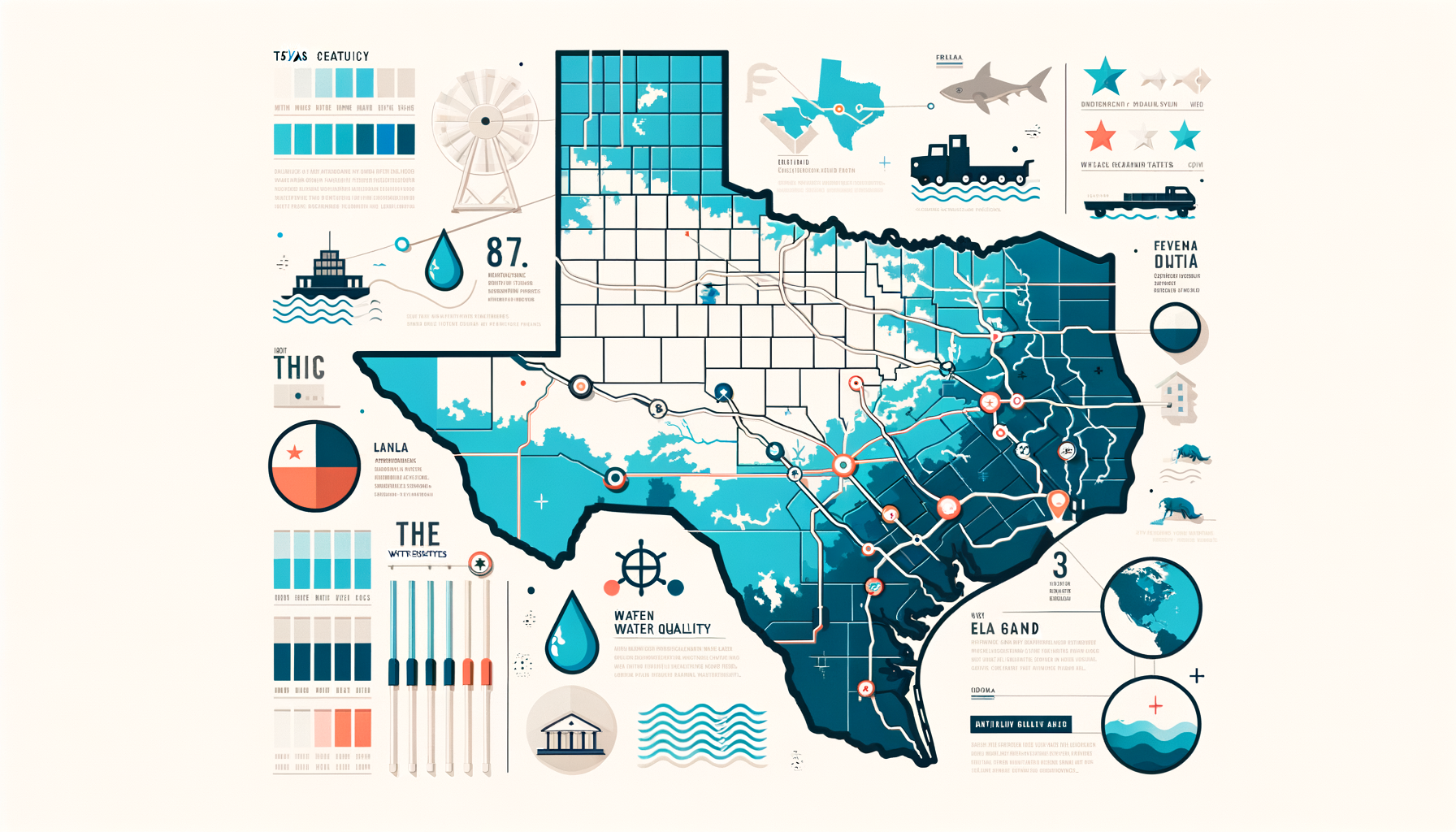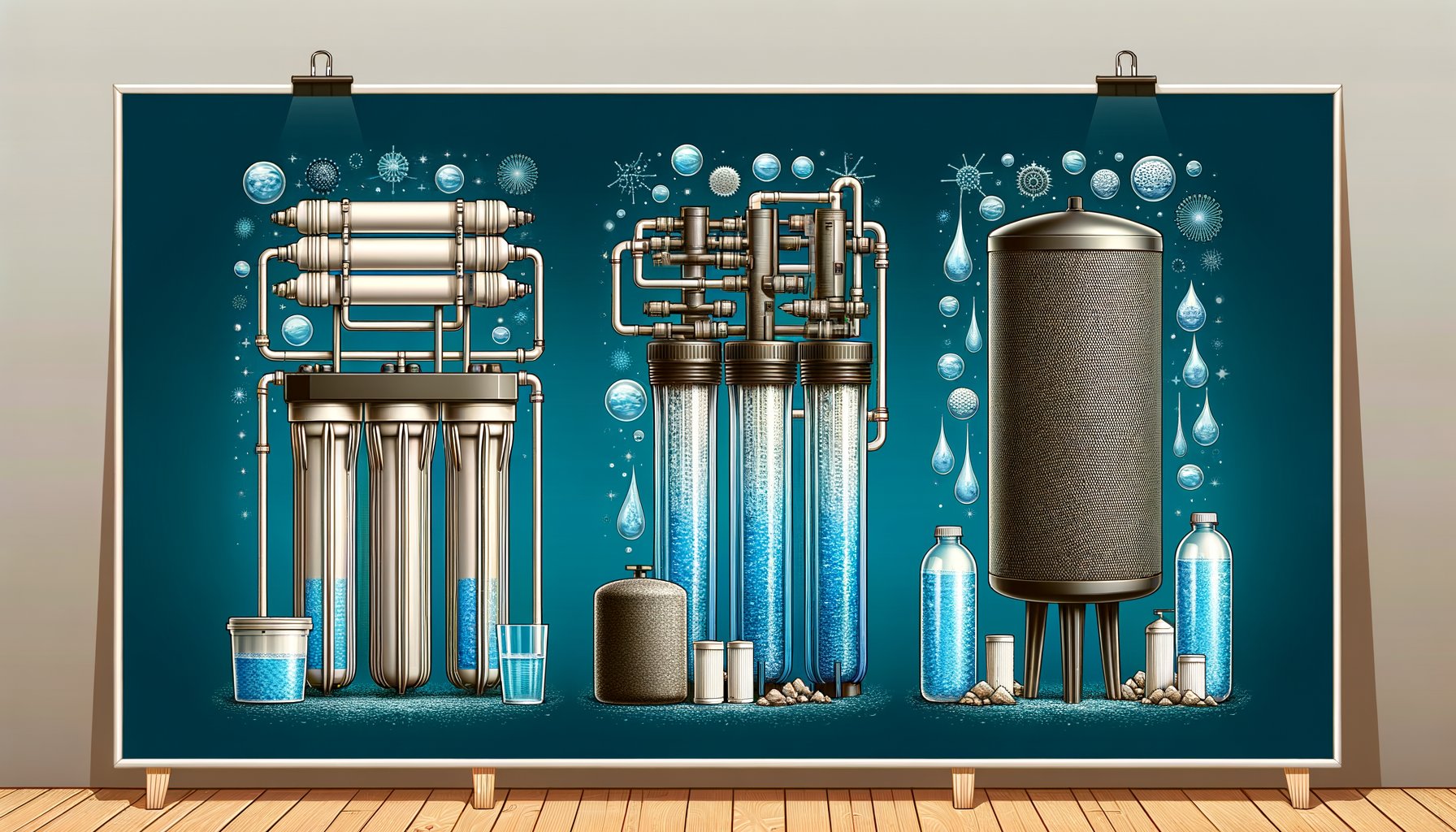Comprehensive Guide to Water Quality in Texas State: Contaminants, Issues, and Water Filtration Solutions
by Ryan Moreau / updated February 13th, 2025
Texas, known for its vast landscapes and booming cities, relies on a complex network of water resources ranging from aquifers to extensive river systems. However, the state faces significant water quality challenges due to industrial activities, agricultural practices, and naturally occurring contaminants. In this comprehensive guide, we delve into the common contaminants found in Texas’s water, regional challenges, and effective filtration solutions. Begin by using our Water Quality Tool to receive a customized analysis of your local water conditions.
Overview of Texas’s Water Sources
Texas’s water supply is as diverse as its geography, encompassing arid deserts, lush forests, and sprawling urban centers. Key sources include:
- Surface Water: Major rivers like the Rio Grande, Colorado, and Brazos provide essential water for municipalities, agriculture, and industry.
- Reservoirs and Lakes: Man-made reservoirs such as Lake Travis and natural lakes like Caddo Lake serve as crucial water storage and supply systems.
- Groundwater Aquifers: The Ogallala, Edwards, and Gulf Coast aquifers are vital for irrigation and drinking water, especially in rural areas.
- Rainwater Harvesting: In some regions, especially where water scarcity is an issue, rainwater collection is an important supplemental source.
Managing water quality across these diverse sources requires coordinated efforts in monitoring, regulation, and implementation of advanced treatment technologies.
Common Water Quality Contaminants in Texas
Texas’s water sources may contain a range of contaminants due to industrial emissions, oil and gas activities, agricultural runoff, and natural mineral deposits. To better understand what may affect your area, start with our Water Quality Tool and then review these common issues:
1. Arsenic
Arsenic naturally occurs in the groundwater of some Texas regions, particularly in West Texas. Long-term exposure can lead to various health problems, including skin lesions and an increased risk of cancer.
Water Filtration Options for Arsenic: Reverse Osmosis Water Filters, Distillation Systems
2. Nitrates
Agricultural areas in Texas often use fertilizers that can leach nitrates into the groundwater. High nitrate levels are especially dangerous for infants, causing conditions like methemoglobinemia or “blue baby syndrome.”
Water Filtration Options for Nitrates: Reverse Osmosis Water Filters
3. Total Dissolved Solids (TDS)
High levels of TDS, including minerals like calcium, magnesium, and sodium, are common in Texas’s groundwater. While not necessarily harmful, high TDS can affect the taste and hardness of water and may indicate the presence of other contaminants.
Water Filtration Options for TDS: Reverse Osmosis Systems, Water Distillers
4. Bacteria and Microbial Contaminants
Flooding and septic system failures can introduce bacteria such as E. coli into water supplies, particularly in rural areas relying on private wells. These pathogens can cause severe gastrointestinal illnesses.
Water Filtration Options for Bacteria: Ultraviolet (UV) purification systems, Reverse Osmosis Systems with UV stages
5. Heavy Metals (Lead, Mercury, and Cadmium)
Industrial activities and aging infrastructure can lead to heavy metal contamination. Exposure to these metals poses serious health risks, including neurological and developmental problems.
Water Filtration Options for Heavy Metals: Reverse Osmosis Systems, Specialized Heavy Metal Filters
6. Fluoride
While fluoride is added to municipal water supplies to promote dental health, some areas in Texas have naturally occurring fluoride levels that exceed recommended limits, potentially leading to fluorosis.
Water Filtration Options for Fluoride: Reverse Osmosis Systems, Activated Alumina Filters
7. Radionuclides
Certain regions in Texas, particularly in the central part of the state, have groundwater that contains radionuclides like uranium and radium due to natural deposits. Long-term exposure increases the risk of cancer.
Water Filtration Options for Radionuclides: Reverse Osmosis Systems, Ion Exchange Systems
8. Petrochemicals and VOCs
Proximity to oil and gas extraction sites can lead to contamination by petrochemicals and volatile organic compounds (VOCs), which are harmful even at low concentrations.
Water Filtration Options for VOCs: Activated Carbon Filters, Air Strippers
9. Pesticides and Herbicides
Intensive agricultural activities contribute to the presence of pesticides and herbicides in both surface water and groundwater. These chemicals can have various adverse health effects.
Water Filtration Options for Pesticides and Herbicides: Activated Carbon Filters, Reverse Osmosis Systems
Regional Water Quality Challenges in Texas
Texas’s vast size and varied industrial activities result in region-specific water quality challenges. According to the Texas Commission on Environmental Quality (TCEQ) and the Environmental Protection Agency (EPA), key issues include:
1. West Texas: High Arsenic and Fluoride Levels
In areas like El Paso and surrounding regions, natural geological formations lead to elevated levels of arsenic and fluoride in groundwater sources.
2. Gulf Coast: Industrial Contamination
The Gulf Coast region, with its concentration of petrochemical plants and refineries, faces contamination from industrial discharges, including VOCs and heavy metals.
3. Central Texas: Radionuclides in Groundwater
Counties in central Texas, such as Lampasas and Mills, have reported higher levels of radionuclides due to underlying geological formations.
4. Agricultural Areas: Nitrate and Pesticide Runoff
The High Plains and other agricultural regions often experience groundwater contamination from nitrates and pesticides due to extensive farming activities.
5. Urban Areas: Aging Infrastructure
Cities like Houston and Dallas may struggle with aging water infrastructure, leading to issues like lead leaching from old pipes and distribution systems.
Addressing these regional challenges requires targeted strategies, including upgrading infrastructure, enforcing stringent regulations, and promoting sustainable practices.
General Water Characteristics in Texas
Texas’s climate and geology contribute to certain general water characteristics that affect both water quality and taste:
1. Hard Water
Hard water is prevalent across much of Texas due to high concentrations of calcium and magnesium in the groundwater. Hard water can cause scale buildup in plumbing fixtures and reduce the efficiency of water heaters and appliances.
For homeowners dealing with hard water, installing a water softener is recommended. If you’re unsure whether you need a water softener or which type best suits your family’s needs, try our Water Softener Calculator for personalized guidance.
2. Alkaline Water
In certain areas, particularly where limestone formations are common, water tends to be more alkaline. While not harmful, alkaline water can affect the taste and may interact with plumbing systems.
Balancing water pH can be achieved with appropriate filtration systems that include pH adjustment stages.
3. Salinity
Close to coastal regions and in some inland areas, elevated salinity levels can be an issue. High salinity affects water taste and can be corrosive to pipes.
Water Filtration Options for Salinity: Reverse Osmosis Systems, Desalination Units
4. Seasonal Variations
Texas experiences significant seasonal variations, with droughts and floods impacting water quality. Flooding can introduce contaminants into water supplies, while droughts can concentrate existing contaminants.
Continuous monitoring and adaptive filtration solutions are necessary to manage these fluctuations effectively.
Utilizing the Water Quality Tool for Texas Residents
Understanding your local water quality is crucial for ensuring safe drinking water. Our Water Quality Tool enables Texas residents to:
- Enter their zip code for a detailed analysis of local water sources
- Access data on common contaminants in public and private water supplies
- Receive personalized recommendations for filtration systems based on your water quality challenges
Recommended Filtration Solutions for Common Texas Contaminants
Based on the prevalent contaminants identified in Texas’s water sources, the following filtration systems are highly recommended:
1. Reverse Osmosis Systems
Reverse Osmosis Systems offer comprehensive removal of arsenic, nitrates, fluoride, radionuclides, and other dissolved solids. They are highly effective for both point-of-use and whole-house applications.
2. Activated Carbon Filters
Activated Carbon Filters are effective at removing organic contaminants, including VOCs, pesticides, and herbicides, as well as improving taste and odor.
3. Water Softeners
Water Softeners address hard water issues by reducing calcium and magnesium levels, protecting your plumbing and improving the efficiency of appliances.
4. UV Purification Systems
Ultraviolet purification systems are effective at eliminating bacteria and viruses, making them an excellent choice for rural areas where microbial contamination is a concern.
Local Water Testing Services in Texas
Accurate water testing is essential to identify the specific contaminants in your water supply. We recommend using SimpleLab for comprehensive water quality analysis. Their easy-to-use kits and detailed lab reports empower you to make informed decisions about your water filtration needs.
Additionally, the Texas Water Development Board provides resources and guidance on water testing and protection strategies.
Case Studies: Addressing Water Quality Issues in Texas
Real-world examples highlight how various water quality challenges in Texas are being addressed:
1. Midland-Odessa: Tackling High TDS and Radionuclides
Residents in the Midland-Odessa area have faced issues with high TDS and radionuclide levels. Community initiatives and the adoption of reverse osmosis systems have significantly improved drinking water quality.
2. Houston: Combating Industrial Pollution
In Houston, efforts to monitor and reduce industrial discharges have been bolstered by citizen advocacy and stricter enforcement of environmental regulations, leading to improved water safety.
3. Rural Communities: Addressing Arsenic Contamination
Small communities in West Texas have implemented centralized treatment facilities and point-of-use filters to effectively reduce arsenic levels in their water supplies.
4. Agricultural Management in the High Plains
Adoption of best management practices in agriculture, such as controlled fertilizer application and buffer zones, has helped to decrease nitrate runoff into water sources.
Call to Action
Texas’s diverse water sources—from sprawling aquifers to extensive river systems—necessitate proactive water quality management. Understanding your local water challenges and implementing effective filtration solutions are essential steps toward safeguarding your household’s health.
Begin by entering your zip code into our Water Quality Tool for a detailed analysis of your water supply. Then, explore our filter review articles to find the most effective system for your needs. Finally, confirm your water’s safety with comprehensive water testing services to ensure you have the clean, safe water your home deserves.







